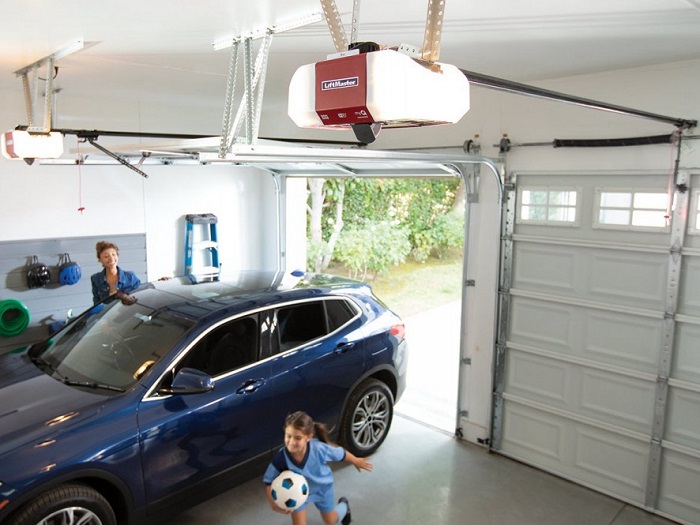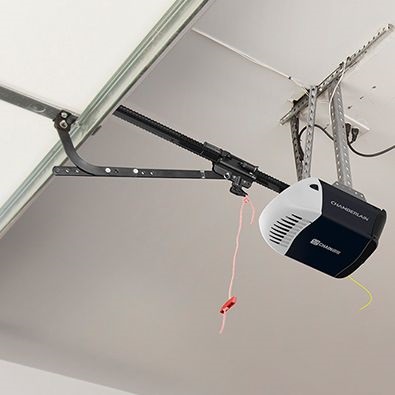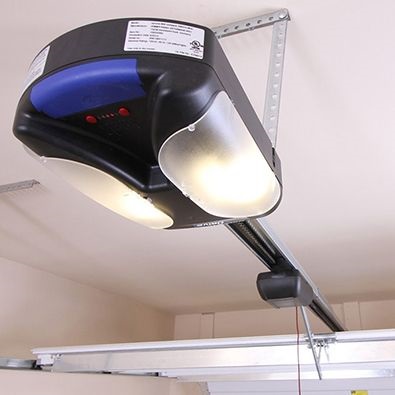A garage door opener gives you easy, illuminated access to your home and can improve security. Features such as smart-device compatibility and home-automation-system connectivity make these devices even more convenient.
Types of Garage Door Openers
Standard garage door openers have a similar design. A motor drives a trolley or carriage along a rail. The trolley is connected to the garage door, and as the trolley moves, it pulls the door open or pushes it closed. The main difference between garage door opener models is how the motor moves the trolley.
A chain-drive garage door opener uses a metal chain to drive the trolley and raise or lower the door. Chain-drive systems are economical choices but tend to create more noise and vibration than other types. If your garage is detached from the house, noise may not be a concern. If the garage is under a living space or a bedroom, you may want to consider a quieter option.
A belt-drive garage door opener functions similarly to the chain-drive system but uses a belt rather than a chain to move the trolley. This belt provides quieter, smoother operation, making it a good choice for homes with living or sleeping spaces above or adjacent to the garage. Belt-drive systems have fewer moving parts, resulting in lower maintenance needs.
A screw-drive garage door opener uses a threaded steel rod to move the lifting mechanism. As the rod rotates, it drives the trolley along the track to raise or lower the door. These units are usually quieter than chain-drive systems. Like belt-drive openers, fewer moving parts mean reduced maintenance.
A direct-drive garage door opener also offers a quiet mechanism. The motor itself functions as the trolley and travels along the track, raising or lowering the door. This means the system has a single moving part — the motor — that results in reduced noise and vibration, as well as fewer maintenance requirements.
Look for horsepower (HP) ratings to compare the lifting power between garage door opener models. Ratings ranging from 1/2 horsepower to 1 1/2 horsepower are typical for residential models. If you have a sectional double-car garage door, a 1/2-horsepower motor should be sufficient, but a higher-power model will operate with less effort and less wear and tear on the motor. Heavier or one-piece doors may require higher horsepower openers. Read our Garage Door Buying Guide to learn about different types of garage doors.
Garage Door Opener Features
Standard garage door openers share common components:
- Remotes, wall-mount buttons or keypads open the garage door.
- A manual release allows you to disengage the opener from inside the garage and raise or lower the door manually.
- A security light activates when you operate the system and turns off automatically after a set period of time.
- Rail segments are typically sized for garage doors up to 7 feet tall.
In addition, look for other features:
- Miniature keychain remotes fit in a pocket.
- Home-automation system connectivity allows you to control your opener remotely.
- Built-in Wi-Fi connects the opener directly to your home wireless network and lets you operate the door from a mobile app without the need for an automation system.
- Smart-device compatibility — built in or available with an optional accessory for some models — allows you to operate and monitor the opener from a mobile device.
- Vehicle compatibility allows operation of the opener from controls built into some vehicles.
- Auto-close functionality lowers a garage door automatically after a pre-programmed period of time.
- Locks give you the option to prevent remotes from opening the garage door.
- Soft-start/-stop motors reduce wear and tear on the opener and make operation quieter.
- Battery backup lets you operate the opener in the event of a power outage.
- Included rail extensions make the opener compatible with 8-foot-high doors.
- Motion-sensing security lights operate automatically.
Safety and Security
If you have an older garage door opener (manufactured before Jan. 1, 1993), consider upgrading the device to take advantage of safety features.
Modern openers generate electronic beams that extend across the garage door opening to provide entrapment prevention and protection. When a person, animal or object breaks the beam, it triggers the safety mechanism, causing a closing door to reverse direction. Garage door openers also feature a mechanism that reverses a closing door when the door contacts an obstacle. Follow the opener manufacturer’s instructions for testing the unit’s safety features.
Newer garage door openers can also improve security. Remotes transmit a unique code to activate the opener. Look for a rolling code feature to prevent code theft, and ensure that a neighbor’s remote control won’t open your garage. Each time you open the door remotely, a new, random code is automatically generated. The garage door opener will accept the new code the next time you operate the remote.





